
Harry Seidler was an Austrian-born Australian architect who is considered to be one of the leading exponents of Modernism's methodology in Australia and the first architect to fully express the principles of the Bauhaus in Australia.
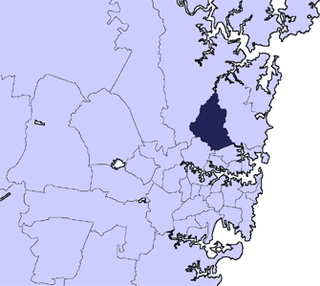
Ku-ring-gai Council is a local government area in Northern Sydney, in the state of New South Wales, Australia. The area is named after the Guringai Aboriginal people who were thought to be the traditional owners of the area. More contemporary research suggests that this was not the case.

Wahroonga is a suburb in the Upper North Shore of Sydney, in the state of New South Wales, Australia, 18 kilometres north-west of the Sydney central business district, in the local government areas of Ku-ring-gai Council and Hornsby Shire. North Wahroonga is a separate suburb to the north, sharing the same postcode.
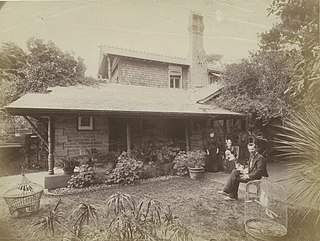
John Horbury Hunt was a Canadian-born Australian architect who worked in Sydney and rural New South Wales from 1863.

The Government House is the heritage-listed vice-regal residence of the governor of New South Wales, Australia, located on Conservatorium Road in the Sydney central business district adjacent to the Royal Botanic Garden, overlooking Sydney Harbour, just south of the Sydney Opera House. Constructed between 1837 and 1843, the property has been the vice-regal residence of the Governor since Sir George Gipps, except for two brief periods; the first between 1901 and 1914, when the property was leased to the Commonwealth of Australia as the residence of the Governor-General of Australia, and the second from 1996 to 2011.

The Harry and Penelope Seidler House is a heritage-listed modernist house located at 13 Kalang Avenue in the Sydney suburb of Killara in the Ku-ring-gai Council local government area of New South Wales, Australia. It was designed by architects Penelope and Harry Seidler and Harry Seidler & Associates, and built from 1966 to 1967 by Peter Cussel. It was added to the New South Wales State Heritage Register on 20 June 2008.
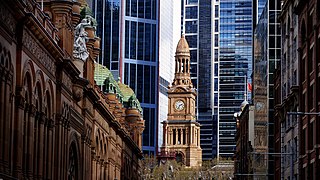
The architecture of Sydney, Australia’s oldest city, is not characterised by any one architectural style, but by an extensive juxtaposition of old and new architecture over the city's 200-year history, from its modest beginnings with local materials and lack of international funding to its present-day modernity with an expansive skyline of high rises and skyscrapers, dotted at street level with remnants of a Victorian era of prosperity.

Australian residential architectural styles have evolved significantly over time, from the early days of structures made from relatively cheap and imported corrugated iron to more sophisticated styles borrowed from other countries, such as the Victorian style from the United Kingdom, the Georgian style from North America and Europe and the Californian bungalow from the United States. A common feature of the Australian home is the use of fencing in front gardens, also common in both the UK and the US.

Woolley House is a heritage-listed residence located at 34 Bullecourt Avenue, Mosman, in the Mosman Council local government area of New South Wales, Australia. It was designed by Ken Woolley and built during 1962 by Pettit, Sevitt and Partners. It was added to the New South Wales State Heritage Register on 25 May 2001. The Woolley House is considered a classic example of the Sydney School style of architecture and was the recipient of the Australian Institute of Architects NSW Chapter Wilkinson Award in the year of its construction, the highest award for housing in New South Wales. In 2003 the house was bequeathed to the Historic Houses Trust of New South Wales.
Penelope Seidler AM is an Australian architect, former member of National Gallery of Australia Council, and current member of the NGA Foundation Board. She is also an accountant and director of the Sydney-based architectural firm Harry Seidler and associates. She was the wife and professional partner of architect Harry Seidler. She was the subject of the 2014 Archibald prize winning portrait by Fiona Lowry.
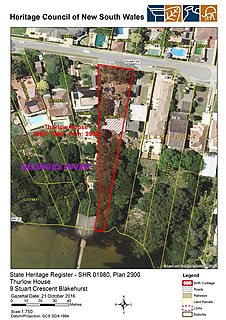
Thurlow House is a heritage-listed residence at 9 Stuart Crescent, Blakehurst in the Georges River Council local government area of New South Wales, Australia. It was designed by Harry Seidler and built from 1953 to 1954. It was added to the New South Wales State Heritage Register on 21 October 2016.
The North Sydney Council Chambers is a landmark civic complex on a block bounded by Miller Street and McLaren Street in North Sydney, New South Wales, Australia. Originally conceived as a Federation Arts and Crafts residence by Edward Jeaffreson Jackson in 1903, the main building served as a private hospital before being purchased by the Municipality of North Sydney for its new chambers in 1925, with sympathetic extensions being completed in 1926, 1938 and 1968 to accommodate for this new usage. While it has remained the seat of North Sydney Council since 1926, the Council Chambers have been further extended with the completion of the modernist Wyllie Wing by Harry Seidler in 1977 and the Carole Baker Building in 2000 by Feiko Bouman.
Buhrich House II is a heritage-listed residence located at 375 Edinburgh Road, Castlecrag, City of Willoughby, New South Wales, Australia. It was designed by Hugh Buhrich and built during 1972. The property is privately by members of the Buhrich family. It was added to the New South Wales State Heritage Register on 25 May 2001.
The Glass House is a heritage-listed domestic dwelling located at 80 The Bulwark, Castlecrag, City of Willoughby, Sydney, New South Wales, Australia. It was designed by Bill Lucas. It is also known as Glasshouse; Bill Lucas House. It was added to the New South Wales State Heritage Register on 21 October 2016.

Mahratta is a heritage-listed former residence and bank executive training facility and now childcare centre, primary school and community group headquarters at 1526 Pacific Highway, Wahroonga, Ku-ring-gai Council, New South Wales, Australia. It was designed by Douglas S. Agnew, Arthur Palin and Paul Sorensen (garden) and built in 1941. It is also known as Mahratta and Site and Heatherlee. The property is owned by The School of Philosophy. It was added to the New South Wales State Heritage Register on 2 April 1999.
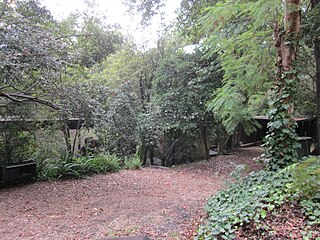
The Jack House is a heritage-listed domestic dwelling at 62 Boundary Road, in the Sydney suburb of Wahroonga in the Ku-ring-gai Council local government area of New South Wales, Australia. It was designed by Russell Jack and Pamela Jack and built from 1956 to 1957 by Donald W. Taylor. It was added to the New South Wales State Heritage Register on 24 June 2013.

Evatt House is a heritage-listed house located at 69 Junction Road in the Sydney suburb of Wahroonga in the Ku-ring-gai Council local government area of New South Wales, Australia. It is also known as Parklands. The property is privately owned. It was added to the New South Wales State Heritage Register on 24 September 2004.

Simpson-Lee House I is a heritage-listed residence located at 23 Roland Avenue, in the Sydney suburb of Wahroonga in the Ku-ring-gai Council local government area of New South Wales, Australia. It was designed by Arthur Baldwinson and built from 1958 to 1962 by George M. Koch. It is also known as Simpson Lee House. It was added to the New South Wales State Heritage Register on 27 November 2009.
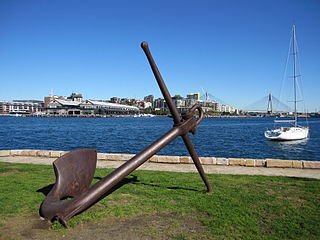
Iloura Reserve is a heritage-listed public reserve on the site of a former timber yard at 10-20 Weston Street, Balmain East, Inner West Council, Sydney New South Wales, Australia. Following the resumption of the timber yard for public space in the 1960s, the present reserve was designed and laid out by landscape architect Bruce Mackenzie and constructed in two stages: stage one in 1970 and stage two in 1981. It is also known as Peacock Point and Illoura. The reserve is owned by the Inner West Council. It was added to the New South Wales State Heritage Register on 29 November 2013.
Torin Building is a heritage-listed former factory and now factory and office space located at 26 Coombes Drive in the western Sydney suburb of Penrith in the City of Penrith local government area of New South Wales, Australia. It was designed by Marcel Breuer and built from 1975 to 1976. It is also known as the Former Torin Corporation Building and Breuer Building. It was added to the New South Wales State Heritage Register on 15 May 2009.
















